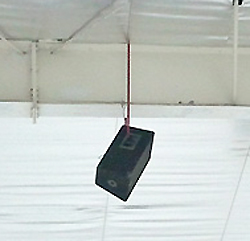It can be very tempting to try to do things for yourself when it comes to upgrading a system, which is great when you can save a few bucks and get the results you’re seeking.
However, before starting, it’s important to be very certain that you’re fully capable of doing it right – no more so than with church A/V systems. Often when I’m working with churches (particularly smaller congregations), the issue of installing things themselves comes up.
It usually revolves around the church purchasing the equipment (hopefully from me – on occasions churches have taken a design I’ve done and then gone online and purchased all of the equipment to install, and then to top it off they call me and ask for advice when it doesn’t work) and then pulling the cables, hanging the loudspeakers and hooking it all up themselves.
I’m all for having volunteers working alongside a qualified contractor. By doing a project in this fashion, the volunteers not only learn a lot about the system, they also get some real “skin in the game” and thus some ownership.
However, based on a lot of years of experience, I’m not a fan of a church doing an installation without the assistance of a professional. Under this scenario I’ve seen and heard some really scary things.
Recently I was at a venue where the ownership had obviously decided to try and save some money on the design and installation of a sound system. It has two loudspeakers that must have been purchased from the local music store – they were a portable design with handles for lugging them around.
To install these loudspeakers, someone came up with the great (not!) idea of throwing a tow strap over a beam and tying each end of the strap to the handles. In a way, it’s somewhat amusing, but it’s also disturbing and more than a little frightening, because these speakers are hanging 20 feet above an area that people travel heavily, thus creating a huge safety issue.
A qualified contractor would never install anything in a fashion that would resemble these hanging weights ready to fall. Further, the coverage is awful. The loudspeakers are almost 80 feet apart, and as I walked through the coverage, I also determined that they must have a 40-degree horizontal coverage pattern (as I traveled into coverage, then out of coverage, then back into coverage…). And the sound coming out of these loudspeakers resembles a total “frown face” EQ setting – harsh midrange and not much else.
So, how can you make a DIY successful rather than something resembling this example?
1) Don’t do any part of an installation that you’re not 100 percent confident that you can do correctly. This seems rather obvious, but a lot of folks do not seem to be able to correctly determine if they are competent enough or not.
2) Pay for and use the advice and instruction from a professional. Don’t just try to pilfer information – be up front with them and ask them to provide you with a price to consult you on the project. Note not all contractors will be willing to help with advice only because they’re not used to doing business this way.
And perhaps more importantly, they may be (rightfully) concerned about the liability issues involved by dispensing advice on how to hand loudspeakers. My suggestion is that any part of an installation that could potentially lead to a safety issue should be left for a professional to do.
3) Select a qualified professional that will act as a partner. Choose a contractor that will work with you in dividing the tasks and responsibilities for the project. For example, the volunteers at a church could pull in all of the cable, with the contractor doing testing and termination.
Saving money and having some ownership in the installation of the system is a good thing, just make sure that you can competently (and safely) perform all of the tasks that you set out to do.


















